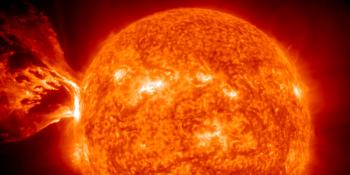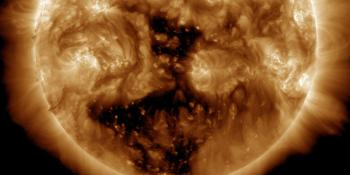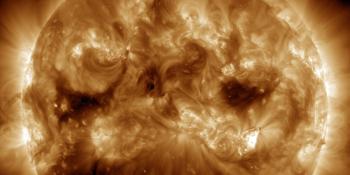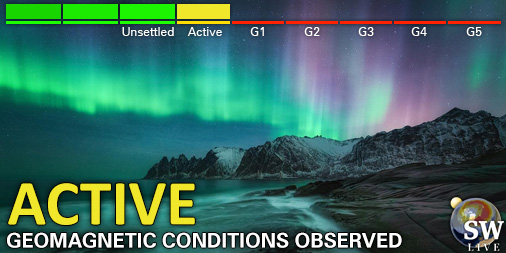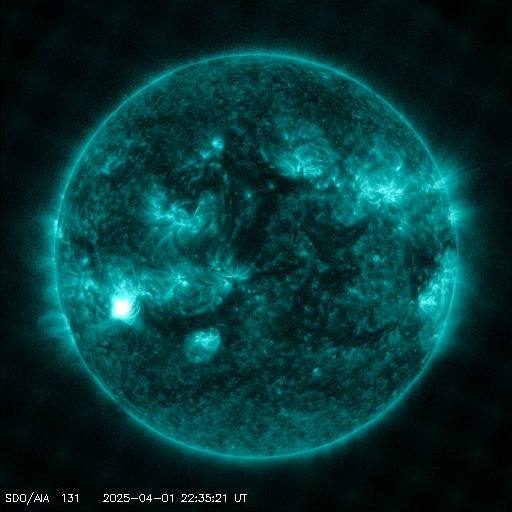Viewing archive of Friday, 23 September 2011
Solar activity report
Any mentioned solar flare in this report has a scaling factor applied by the Space Weather Prediction Center (SWPC). Because of the SWPC scaling factor, solar flares are reported as 42% smaller than for the science quality data. The scaling factor has been removed from our archived solar flare data to reflect the true physical units.
Report of Solar-Geophysical Activity 2011 Sep 23 2200 UTCPrepared by the NOAA © SWPC and processed by SpaceWeatherLive.com
Joint USAF/NOAA Report of Solar and Geophysical Activity
SDF Number 266 Issued at 2200Z on 23 Sep 2011IA. Analysis of Solar Active Regions and Activity from 22-2100Z to 23-2100Z
Solar activity was moderate. An M1/1n flare was
observed at 23/0159Z from Region 1295 (N25W74) along with several
C-class flares, including an long-duration flare at 23/0850Z. Region
1302 (N13E58) remains the most significant region on the disk as an
Eki Beta-Gamma with an area of 780 millionths.
IB. Solar Activity Forecast
Solar activity is expected to be high,
with a slight chance for another X-class flare from Region 1302.
IIA. Geophysical Activity Summary 22-2100Z to 23-2100Z
The geomagnetic field was quiet. The 10 MeV protons at geosynchronous
orbit are expected to exceed the 10 pfu threshold during the period.
IIB. Geophysical Activity Forecast
The geomagnetic field is
expected to be quiet on day one (24 September). Quiet, with isolated
unsettled levels, are expected on day two (25 September), due to a
weak coronal hole high-speed stream. Quiet levels are expected on
day three (26 September).
III. Event Probabilities 24 Sep to 26 Sep
| Class M | 70% | 70% | 70% |
| Class X | 20% | 20% | 20% |
| Proton | 90% | 80% | 50% |
| PCAF | green | ||
IV. Penticton 10.7 cm Flux
Observed 23 Sep 158 Predicted 24 Sep-26 Sep 160/165/170 90 Day Mean 23 Sep 106
V. Geomagnetic A Indices
Observed Afr/Ap 22 Sep 002/003 Estimated Afr/Ap 23 Sep 002/004 Predicted Afr/Ap 24 Sep-26 Sep 005/005-007/008-005/005
VI. Geomagnetic Activity Probabilities 24 Sep to 26 Sep
| A. Middle Latitudes | |||
|---|---|---|---|
| Active | 05% | 10% | 05% |
| Minor storm | 01% | 01% | 01% |
| Major-severe storm | 01% | 01% | 01% |
| B. High Latitudes | |||
|---|---|---|---|
| Active | 10% | 15% | 10% |
| Minor storm | 01% | 01% | 01% |
| Major-severe storm | 01% | 01% | 01% |
All times in UTC
Latest news
Latest forum messages
AR4048 106Unexplained proton activity 54AR4046 157Temporary Topic - Ongoing Solar Proton Events 17jsoc 108
More topicsSupport SpaceWeatherLive.com!
A lot of people come to SpaceWeatherLive to follow the Sun's activity or if there is aurora to be seen, but with more traffic comes higher server costs. Consider a donation if you enjoy SpaceWeatherLive so we can keep the website online!

Latest alerts
13:03 UTC - Hemispheric Power Index
The OVATION model predicts the Hemispheric Power Index to reach 50GW at 13:56 UTC
Wednesday, 2 April 2025
04:03 UTC - Hemispheric Power Index
The OVATION model predicts the Hemispheric Power Index to reach 50GW at 04:56 UTC
01:45 UTC - Geomagnetic activity
Active geomagnetic conditions (Kp4) Threshold Reached: 01:32 UTC
Tuesday, 1 April 2025
22:51 UTC - Solar flare
Moderate M2.5 flare
22:30 UTC - Radio Blackout
Minor R1 radio blackout in progress (≥M1 - current: M1.45)
Space weather facts
| Last X-flare | 2025/03/28 | X1.1 |
| Last M-flare | 2025/04/01 | M2.5 |
| Last geomagnetic storm | 2025/03/27 | Kp5 (G1) |
| Spotless days | |
|---|---|
| Last spotless day | 2022/06/08 |
| Monthly mean Sunspot Number | |
|---|---|
| February 2025 | 154.6 +17.6 |
| April 2025 | 152.5 -2.1 |
| Last 30 days | 130.7 -17.9 |
